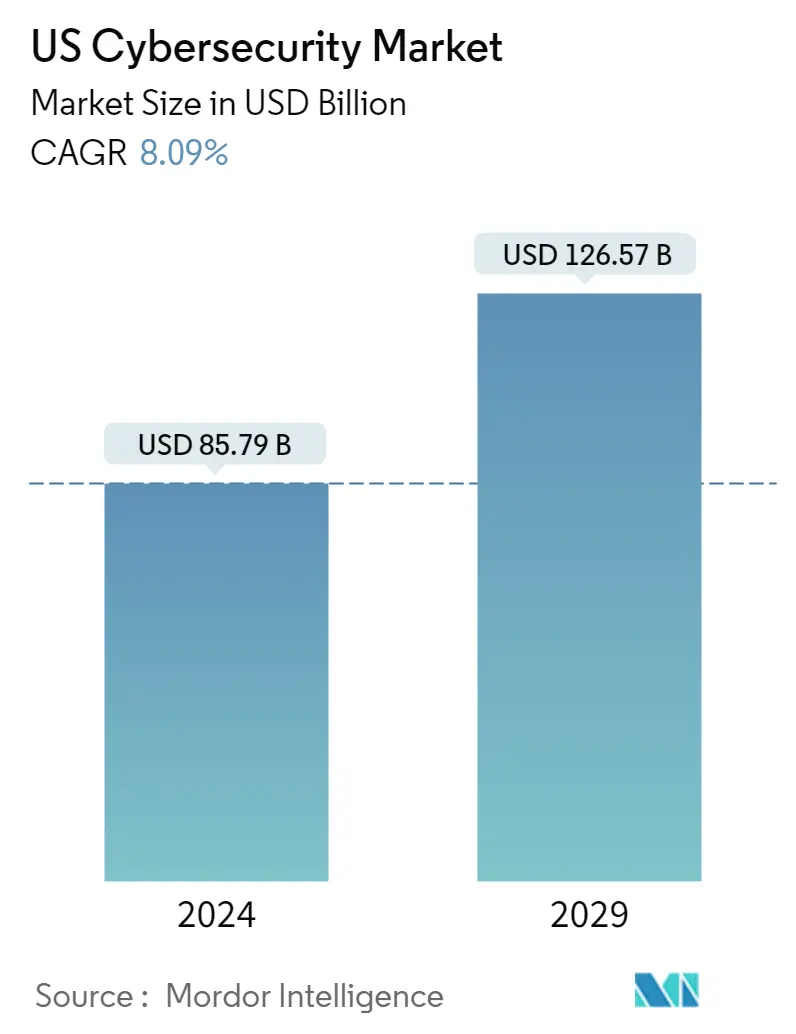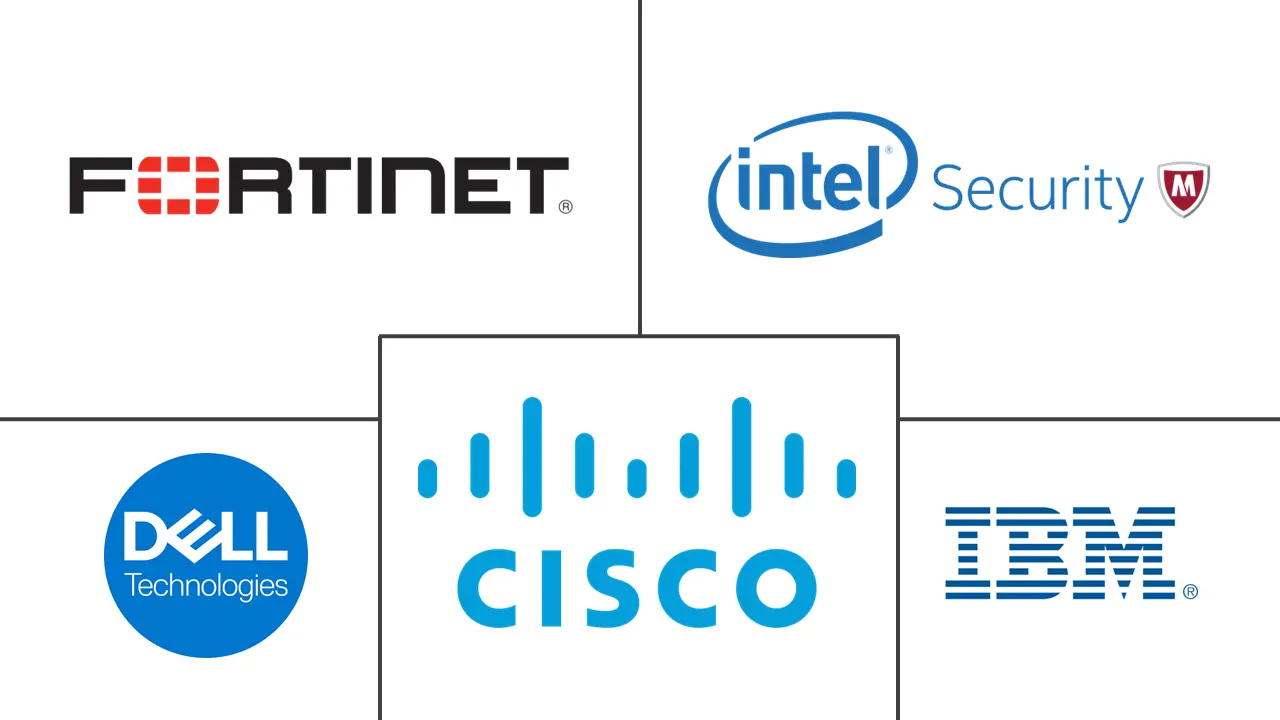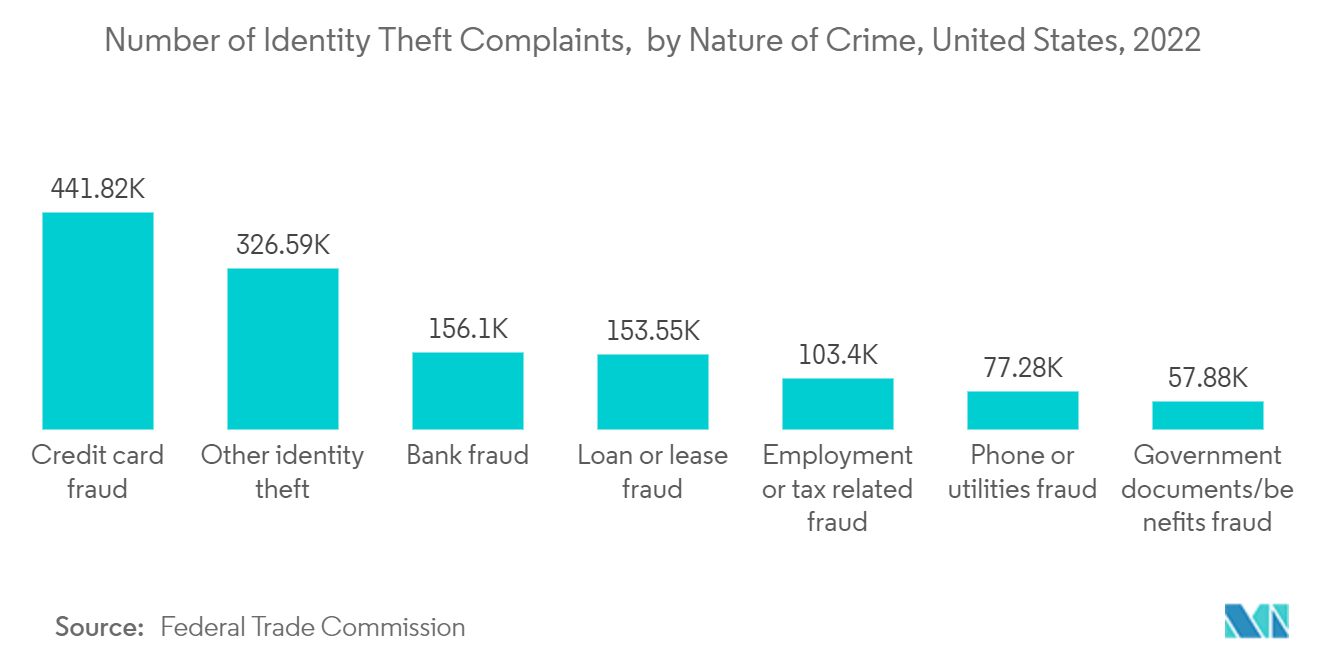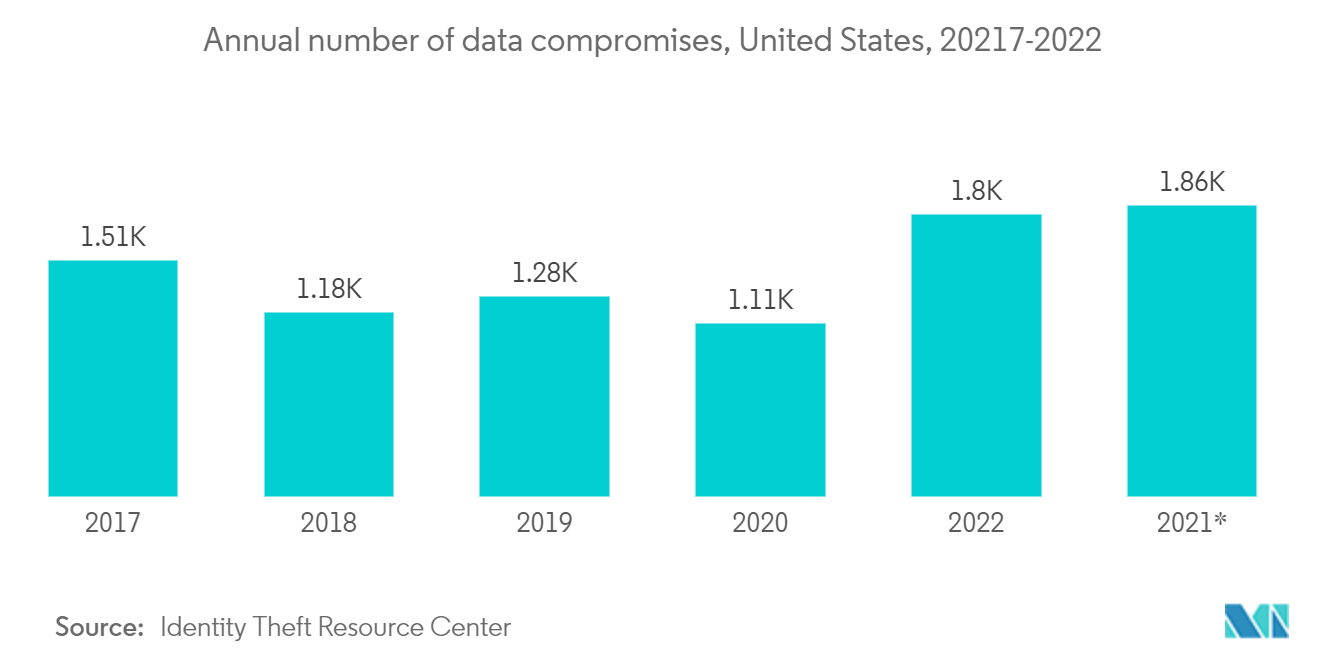US Cybersecurity Market Size

| Study Period | 2019 - 2029 |
| Base Year For Estimation | 2023 |
| Market Size (2024) | USD 85.79 Billion |
| Market Size (2029) | USD 126.57 Billion |
| CAGR (2024 - 2029) | 8.09 % |
| Market Concentration | Medium |
Major Players
*Disclaimer: Major Players sorted in no particular order |
US Cybersecurity Market Analysis
The US Cybersecurity Market size is estimated at USD 85.79 billion in 2024, and is expected to reach USD 126.57 billion by 2029, growing at a CAGR of 8.09% during the forecast period (2024-2029).
The difficulty of protecting against a persistent information security breach is one that businesses in all industries in the United States are currently confronting. To fight against incoming threats and safeguard sensitive data, security experts are expected to keep ahead of dangers and use technologies, policies, and processes. Additionally, enterprises need to be able to swiftly and securely modify their core business applications across on-premise, SDN, and cloud environments as they speed up their digital transformation activities. This means that to manage these operations, IT and security teams need to have a complete awareness of fine-grained control over their whole network architecture.
- The market's expansion might be ascribed to the sophistication of cyberattacks, which is rising. Over the past ten years, the number and severity of cybercrimes and scams have escalated, causing enormous losses for enterprises. As cybercrimes have dramatically escalated, businesses have focused their expenditure on information security solutions to bolster their internal security infrastructures. The use of targeted assaults, which penetrate targets' network infrastructure while remaining anonymous, has increased recently. Endpoints, networks, on-premises devices, cloud-based apps, data, and numerous other IT infrastructures are frequently targeted by attackers who have a specific target.
- For instance, in March 2021, Hackers targeted four security flaws in Microsoft Exchange Server email software; they used the bugs on the Exchange servers to access email accounts of at least 30,000 organizations across the United States, which included small businesses, towns, cities, and local governments. The attack allowed the hackers to remotely control the affected systems, allowing them access to potential data theft and further compromise.
- Following a public call asking government agencies in the region to join forces with the private sector and academia to ensure that medical facilities are protected from cyber threats. Various collaborations have been taking place in the industry. For instance, in March 2022, Senators of the United States Parliament introduced Healthcare Cybersecurity Act. The Act aims to promote collaboration between Cybersecurity and Infrastructure Security Agency (CISA) and HHS to enhance cybersecurity efforts across the healthcare and public health sector.
- In January 2022, the federal banking regulators of the United States issued a cybersecurity rule requiring prompt notification of a breach. The proposed rule is poised to provide the agencies with an early warning of considerable computer security incidents. It would need notification as soon as possible and no later than 36 hours after a banking enterprise determines that an incident has occurred. Such regulations could control the cyber attacks in the banking sector of the United States.
- According to the US Department of Homeland Security (DHS) Cybersecurity, there has been a sharp increase in phishing and malware distribution using COVID-19-themed lures, the registration of new domain names containing words related to coronavirus or COVID-19, and attacks against recently and swiftly deployed remote access and teleworking infrastructure. As businesses prepare to implement months-long business continuity plans (BCP), including information security monitoring and response while working under quarantine circumstances, focusing on increasing cybersecurity, the pandemic has further expedited the need for cybersecurity.
US Cybersecurity Market Trends
Need For Identity Access Management is One of the Factor Driving the Market
- With the rapid digitalization across the country, digital identity has become crucial to enforcing access controls. As a result, identity and access management (IAM) has become a significant priority for modern enterprises.
- The United States has one of the highest digital penetration rates globally, with many users and organizations depending upon IoT devices and computing solutions. Organizations all over the US increasingly depend on computer networks, smart devices, and electronic data to conduct their daily operations, which has led to growing pools of personal and financial information transferred and stored online. Hence, the need for identity and access management solutions increased over time.
- IAM, viewed as an operational back-office issue, is now gaining board-level visibility following several high-level breaches that have occurred due to the failure of organizations to manage and control user access effectively. The prominence of IAM has been further elevated by an evolving regulatory landscape and trends, such as Bring your Device (BYOD) and cloud adoption. The risks related to accessing information and data have also increased significantly.
- According to the Federal Trade Commission, the prevalence of identity thefts in the banking and payment industries in the United States would encourage more people to use biometric solutions. Financial institutions like TD Bank that operate in the United States are reportedly focusing on digital identity verification solutions to strengthen the customer onboarding processes, with a significant contribution to verifying the CIP and KYC procedures, according to Pymnts' release of the Digital Identity Tracker Report in March 2022. The software solutions are expected to gain more traction as financial institutions nationwide examine implementing various identity verification tools.
- The impact of an identity management cybersecurity breach by organized crime, state-sponsored militaries, and others is packed with implications that can impact staff productivity and morale, apart from substantial financial and potential life losses and further damage to the IT network and company reputation. These risks demand a new level of identity and access management solutions.

BFSI Segment Is Boosting The Cybersecurity Market Growth
- The BFSI industry is one of the critical infrastructure segments that face multiple data breaches and cyber-attacks, owing to the massive customer base that the sector serves and the financial information that is at stake. Being a highly lucrative operation model with phenomenal returns and the added upside of relatively low risk and detectability, cybercriminals are optimizing a plethora of diabolical cyberattacks to immobilize the financial sector. These attacks' threat landscape ranges from Trojans, malware, ATM malware, ransomware, mobile banking malware, data breaches, institutional invasion, data thefts, fiscal breaches, etc.
- With a strategy to secure their IT processes and systems, secure customer critical data, and comply with government regulations, public and private banking institutes focus on implementing the latest technology to prevent cyber attacks. Besides, with greater customer expectations, rising technological capabilities, and regulatory requirements, banking institutions are pushed to adopt a proactive security approach. With the growing technological penetration and digital channels, such as Internet banking, mobile banking, etc., online banking has become customers' preferred choice for banking services. There is a significant need for banks to leverage advanced authentication and access control processes.
- The country also marked the increase of ransomware and phishing attacks targeted at organizations that involved less manual effort and were highly automated in 2022. In 2022, financial firms worldwide were impacted by innovative new ransomware tactics that maximized ROI for the threat actors. While financial firms represent a small percentage of victims directly targeted by ransomware attacks, they can and have been impacted by attacks on third parties, who are prime targets. Such threats are poised to increase the usage of cybersecurity solutions in the BFSI sector.
- Moreover, in light of Russia - Ukraine conflict and a virtually endless cycle of threat campaigns and vulnerability disclosures towards the country, the US State Department, on April 2022, launched a new agency, the Bureau of Cyberspace and Digital Policy (CDP), responsible for developing online defense and privacy-protection policies and direction as the Biden administration seeks to integrate cybersecurity into America's foreign relations.

US Cybersecurity Industry Overview
The united states cybersecurity market is moderately consolidated, with the presence of a large number of SME vendors and dominant major companies in the market. The companies are continuously investing in making strategic partnerships and product developments to gain more market share. Some of the recent developments in the market are:
- May 2022 - Google plans to acquire Mandiant, a United States-based cybersecurity firm. Post-acquisition the company will most likely join Google's cloud computing division. The move to acquire Mandiant stems from Google's plan to strengthen its cybersecurity footprint and create a robust portfolio compared to its competitors in the market.
- May 2022: Cisco Systems Inc. announced that, it has released the Cisco Cloud Controls Framework (CCF) to the public. Cisco CCF is a comprehensive set of national and international security compliance and certification requirements, aggregated in one framework.
US Cybersecurity Market Leaders
-
IBM Corporation
-
Cisco Systems Inc
-
Dell Technologies Inc.
-
Fortinet Inc.
-
Intel Security (Intel Corporation)
*Disclaimer: Major Players sorted in no particular order
.webp)
US Cybersecurity Market News
- March 2022 - Google Cloud announced it is acquiring cybersecurity firm Mandiant, a player in proactive SaaS-based security. In light of the growing impact of cybercrime on all businesses across the country, the acquisition emphasizes the necessity of security for all enterprises, regardless of size. Mandiant will be acquired for an all-cash price of USD 23 per share in a deal worth USD 5.4 billion. Once the necessary stockholder and regulatory clearances are obtained, Mandiant will merge with Google Cloud.
- March 2022 - HelpSystems declared that it had signed a merger agreement to acquire AlertLogic, a player in managed detection and response (MDR) services. The company's MDR solutions focus on reducing the intense pressure faced by organizations due to the increase in cyberattacks and the significant shortage of skilled professionals available to prevent and repair cyberattacks. Alert Logic will be the basis of HelpSystems' cybersecurity portfolio.
US Cybersecurity Market Report - Table of Contents
1. INTRODUCTION
- 1.1 Study Assumptions and Market Definition
- 1.2 Scope of the Study
2. RESEARCH METHODOLOGY
3. EXECUTIVE SUMMARY
4. MARKET INSIGHTS
- 4.1 Market Overview
- 4.2 Value Chain Analysis
-
4.3 Porter's Five Forces Analysis
- 4.3.1 Threat of New Entrants
- 4.3.2 Bargaining Power of Buyers
- 4.3.3 Bargaining Power of Suppliers
- 4.3.4 Threat of Substitutes
- 4.3.5 Intensity of Competitive Rivalry
- 4.4 Impact of Covid-19 on the Market
5. MARKET DYNAMICS
-
5.1 Market Drivers
- 5.1.1 Increasing Demand for Digitalization and Scalable IT Infrastructure
- 5.1.2 Need to tackle risks from various trends such as third-party vendor risks, the evolution of MSSPs, and adoption of cloud-first strategy
-
5.2 Market Restraints
- 5.2.1 Lack of Cybersecurity Professionals
- 5.2.2 High Reliance on Traditional Authentication Methods and Low Preparedness
-
5.3 Trends Analysis
- 5.3.1 Organizations in Thailand increasingly leveraging AI to enhance their cyber security strategy
- 5.3.2 Exponential growth to be witnessed in cloud security owing to shift toward cloud-based delivery model.
6. MARKET SEGMENTATION
-
6.1 By Offering
- 6.1.1 Security Type
- 6.1.1.1 Cloud Security
- 6.1.1.2 Data Security
- 6.1.1.3 Identity Access Management
- 6.1.1.4 Network Security
- 6.1.1.5 Consumer Security
- 6.1.1.6 Infrastructure Protection
- 6.1.1.7 Other Types
- 6.1.2 Services
-
6.2 By Deployment
- 6.2.1 Cloud
- 6.2.2 On-premise
-
6.3 By End User
- 6.3.1 BFSI
- 6.3.2 Healthcare
- 6.3.3 Manufacturing
- 6.3.4 Government & Defense
- 6.3.5 IT and Telecommunication
- 6.3.6 Other End Users
7. COMPETITIVE LANDSCAPE
-
7.1 Company Profiles
- 7.1.1 IBM Corporation
- 7.1.2 Cisco Systems Inc
- 7.1.3 Dell Technologies Inc.
- 7.1.4 Fortinet Inc.
- 7.1.5 Intel Security (Intel Corporation)
- 7.1.6 F5 Networks, Inc.
- 7.1.7 AVG Technologies
- 7.1.8 IDECSI Enterprise Security
- 7.1.9 FireEye Inc.
- 7.1.10 Cyberark Software Ltd
- *List Not Exhaustive
8. INVESTMENT ANALYSIS
9. FUTURE OF THE MARKET
** Subject To AvailablityUS Cybersecurity Industry Segmentation
Cybersecurity solutions help an organization to monitor, detect, report, and counter cyber threats that are internet-based attempts to damage or disrupt information systems and hack critical information using spyware and malware, and by phishing, to maintain data confidentiality. The United States Cybersecurity Market is segmented by Offering ( Security type (Cloud, Data Security, Identity Access Management, Network Security, Consumer Security, Infrastructure Protection), Services), by Deployment (Cloud, On- Premise) and by End User ( BFSI, Healthcare, Manufacturing, Government and Defense, IT and Telecommunication). The market sizes and forecasts are provided in terms of value (USD) for all the above segments.
| By Offering | Security Type | Cloud Security |
| Data Security | ||
| Identity Access Management | ||
| Network Security | ||
| Consumer Security | ||
| Infrastructure Protection | ||
| Other Types | ||
| By Offering | Services | |
| By Deployment | Cloud | |
| On-premise | ||
| By End User | BFSI | |
| Healthcare | ||
| Manufacturing | ||
| Government & Defense | ||
| IT and Telecommunication | ||
| Other End Users |
US Cybersecurity Market Research FAQs
How big is the US Cybersecurity Market?
The US Cybersecurity Market size is expected to reach USD 85.79 billion in 2024 and grow at a CAGR of 8.09% to reach USD 126.57 billion by 2029.
What is the current US Cybersecurity Market size?
In 2024, the US Cybersecurity Market size is expected to reach USD 85.79 billion.
Who are the key players in US Cybersecurity Market?
IBM Corporation, Cisco Systems Inc, Dell Technologies Inc., Fortinet Inc. and Intel Security (Intel Corporation) are the major companies operating in the US Cybersecurity Market.
What years does this US Cybersecurity Market cover, and what was the market size in 2023?
In 2023, the US Cybersecurity Market size was estimated at USD 79.37 billion. The report covers the US Cybersecurity Market historical market size for years: 2019, 2020, 2021, 2022 and 2023. The report also forecasts the US Cybersecurity Market size for years: 2024, 2025, 2026, 2027, 2028 and 2029.
What are the leading Cybersecurity Solutions in demand?
The leading Cybersecurity Solutions in demand are: a) Identity and access management b) Threat detection and response c) Encryption d) Data loss prevention solutions
US Cybersecurity Industry Report
The United States cyber security market is on an upward trajectory, fueled by the escalating demand for digital protection across diverse sectors. This growth is propelled by digital transformation, the adoption of cloud-based services, and the integration of cutting-edge technologies such as IoT and AI, necessitating advanced cyber security solutions. Investments are surging to develop technologies to combat evolving cyber threats, with network security and cloud application security in high demand due to BYOD policies and digitalization. The market, vital for enterprises of all sizes, is booming, particularly in BFSI, healthcare, and government sectors, to protect sensitive data and meet regulatory standards. The competitive landscape sees key players innovating and forming strategic partnerships to address the security needs of businesses in the United States. For detailed insights, Mordor Intelligence™ offers comprehensive analysis and forecasts on the US cybersecurity market share, size, revenue growth rate, including a free report PDF download for a snapshot of this dynamic industry.



